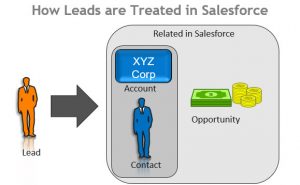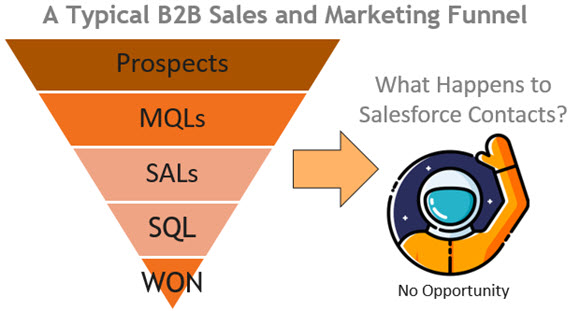Every company wants more marketing qualified prospects feeding the Sales team. However, a funny thing can happen with organizations that leverage Salesforce–A Lead can get converted into a Contact and never get seen again, almost like George Clooney in Gravity.
The end result is significant lead leakage and wasted investment as these Contacts can fall out of the funnel.
Does your company convert Leads into Contacts without adding them to an Opportunity? If so, what are you doing to make sure these prospects are not lost in space? In this post, I’ll cover some of the top lifecycle issues many companies face around this situation and what you can do to bring your prospects back to earth.
Salesforce: Lead vs Contact

The Contact and Lead terminology within Salesforce can be a bit tricky. Remember that Salesforce was founded way back in 1999 back when Napster was founded–heck, we couldn’t figure out the MP3 process, never mind a closed loop marketing and sales system. The relationship between them all is kind of like the old Abbott & Costello Who’s on First routine.
In Salesforce, a Lead is someone who needs to be worked–a Contact is someone who is known and belongs to an Account (Which may or may not have an Opportunity). The issue is Salesforce treats Leads and Contacts differently, which poses all kinds of tracking and lead flow process issues.
Fast forward to today and organizations are trying to retrofit their entire Sales and Marketing efforts to these varying concepts.
Your Lifecycle: Where Contacts Get Lost

Are Your Contacts a Permanent Detour?
The typical situation looks something like this. A person from a major brand like Disney fills out a website form for an eBook and becomes a Lead. The Business Development Representative (BDR) sees that hot activity and then adds that person to the Disney Account as a Contact. This allows the appropriate Account Executive (AE) to manage it accordingly. This process sounds good in theory but it can cause a whole host of issues.
The big disconnect here is that the Contact has no associated Opportunity in Salesforce. Because Marketing tends to measure Leads while Sales tends to measure Opportunities, a Contact without an Opportunity can fall out of vision and that’s not a good thing. Don’t think these numbers are significant? I’ve seen 30% or more Contacts that don’t have Opportunities.
A Few Examples
- Lack of Follow-Up: AEs aren’t BDRs. I’ve seen it time and time again like a broken record. A Lead gets converted to a Contact and gets assigned to a BDR. BDRs are supposed to call it X times but because the person is part of an existing account, the BDR reassigns it to an AE. Because many companies only have service level agreements and alerts triggers for Leads, the prospect falls off the radar as it’s technically a Contact. Does the person get contacted? Maybe. Maybe not.
- Poor Nurture Communications. Often a new Lead drops into a company’s nurture track for email communications. What happens for this new Contact? Will this person receive any communications at all? Will it receive a generic email communication even though it belongs to an Account? For example, shouldn’t a person from a top Account like Disney receive a different communication?
- Lost in System. Let’s say your company hosts an awesome webinar with 500 attendees? 100 Leads hit a lead score threshold and pass over to the BDR team. What happens to the Contacts that are sitting in the system that were already passed to AEs? Because the Contacts are sitting outside the process, many times they don’t receive any followup. That’s a huge opportunity lost.
- Where’s the Upsell? Big companies tend to work on a departmental/divisional level. For example, a person from Disney Interactive most likely doesn’t know what’s going on at Disney Consumer Products. If none of the above are handled properly, that upsell/cross-sell opportunity could get lost.
- Salesforce Doesn’t Make it Easy. Salesforce has all kinds of lead queue views that help Sales manage Leads. Contacts are a whole other ballgame and must be managed separately via reports using standard Salesforce processes.
Stop the Leaking Funnel
So where do you turn? Let’s dive into a few approaches that can help reduce those Contacts leaking out of your funnel.
Develop a Unified Salesforce Lead & Contact Model

Technically, Leads and Contacts are different but this approach treats them the same.
This approach uses a single field that ties both Leads and Contacts together. Let’s call it the Lifecycle field. Or maybe it’s a Contact Status field that is Mapped to a Lead Status field. For companies that work Leads and Contacts in parallel, this process gives more flexibility and better management. Here, reps and marketing focus on the Lifecycle field to manage prospects through the funnel, ignoring whether or not the person is a Lead or a Contact. Only Contacts can have a Won or Opportunity stage.
For example, if a Lead with a Lifecycle status field value of “Sales Accepted” is converted to a Contact, it will still maintain its Lifecycle status value. This will allow the rep to work that Contact just like a Lead. The big caveat is the Lead will no longer be a Lead in the rep’s standard Lead queue meaning the rep needs to manage the Contact using a different process (Like a report).
From a Marketing perspective, Marketing can deliver content and run reports against the Lifecycle status in its marketing automation platform. It really doesn’t matter if the person is a Lead or a Contact because the Lifecycle status treats the person the same.
Another approach: Convert all Leads to Contacts and manange them there. We are seeing this approach more and more, especially as companies adopt ABM strategies. When using this approach. leveraging Lead-to-Account matching technologies like a LeanData help streamline this process.
Benefits Include:
- Complete Visibility of Leads and Contacts. Because EVERYONE is now accounted for, fewer prospects will leak out of the funnel. For example, allowing Contacts to hit MQL enables the Sales team to get visibility into their success. Otherwise they can get lost in the system.
- Better Experience. Marketing can now have more control over what happens to a person during their lifecycle journey from a nurturing perspective.
- Not a Permanent Detour. Prospects don’t get stuck in the Contact graveyard. They can recycle back to Sales just like a Lead would.
- More Cross-sell and Upsell opportunities. Having Contacts MQL and Recycle might uncover completely new opportunities within the same account.
- Account Building. Let’s say Disney has 100 Contacts in your system. If any of those take action, each will MQL as a Contact individually.
Some Caveats
The approach still doesn’t fix Saleforce’s lack of management for Lead and Contact processes. Companies must develop strong processes for both Lead AND Contact management.
Additionally, reporting across Leads and Contacts in Salesforce is no easy task unless you have some custom built, cross object reporting. Thankfully, there are some third party providers that are offering insights into the Unified Salesforce Lead & Contact Model.
Account-Based Marketing Approach
Related to the Unified Salesforce Lead & Contact Model, Leads and Contacts are always related to some company. However, only Contacts are tied to Accounts in Salesforce. This can cause lead routing issues and lack of email personalization.
I’ll save this subject for another post but know that several companies such as Lean Data, Engagio, Ringlead and others are developing solutions to address some of these challenges with an account-based approach.
Salesforce Leads and Contacts-The Verdict
There are many shades of grey when it comes to managing Contacts and Leads. A Unified Lead and Contact approach works in many cases but not all. Which approach works best for your organization?
Let us know what you think in the comments below!


